Arduino I/O Expansion Shield
Introduction
The Arduino I/O Expansion Shield provides an easy way to connect sensors, servos and RS485 device to Arduino board. It expands Arduino’s Digital I/O and Analog Input Pins with Power and GND. It also provides separate PWM Pins which are compatible with standard servo connector. Another unique feature is that the I/O shield has a build-in RS485 converter which allows Arduino communicating with RS485 devices. The communication socket provides an extremely easy way to plug a wireless module such as APC220 RF module and DF-Bluetooth module. It has an individual power input for Servos. A servo power jumper allows user to select using external power or internal power to drive the Servos.
Diagram
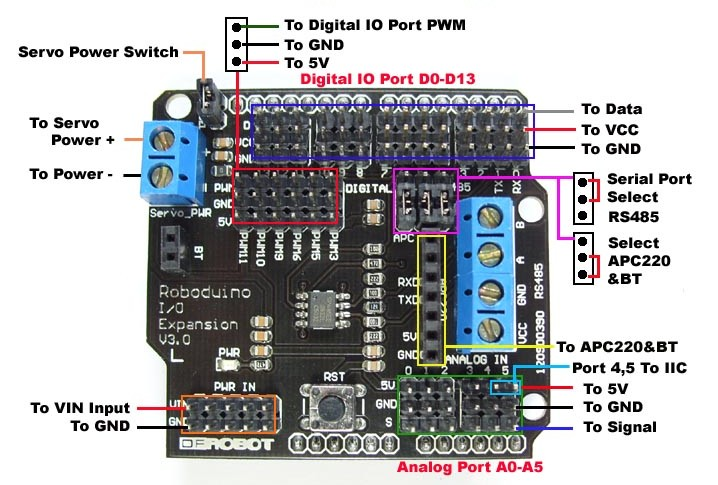
Sample Code
Not available
 Go Shopping [Arduino I/O Expansion Shield(SKU: DFR0014)]
Go Shopping [Arduino I/O Expansion Shield(SKU: DFR0014)]
Arduino Motor Shield (L293)
Introduction
This motor shield allows Arduino to drive two channel DC motors. It uses a L293B chip which deliveries output current up to 1A (2A for L298P version) each channel. The speed control is achieved through conventional PWM which can be obtained from Arduino’s PWM output Pin 5 and 6. The enable/disable function of the motor control is signalled by Arduino Digital Pin 4 and 7. Roboduino Motor Shield uses PWM output Pin 6 and 9 and Digital Pin 7 and 8.
The Motor shield is powered directly from Arduino. It is strongly advised that use external power supply to power the Arduino instead of the USB power supply.
Diagram
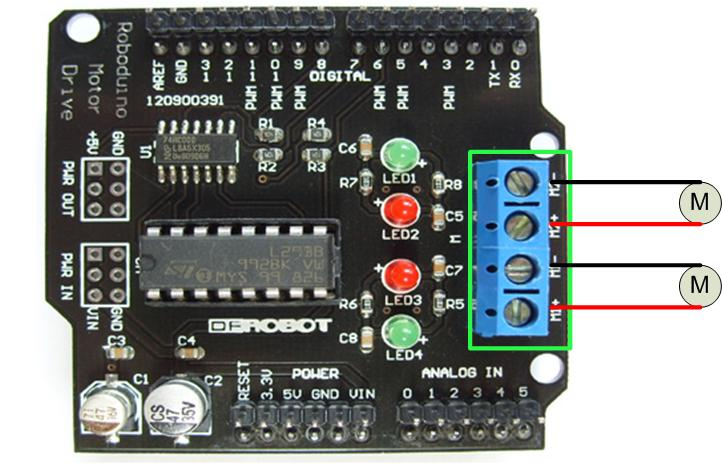
Pin Allocation
| Pin | Function |
|---|---|
| Digital 4 | Motor 2 Direction control |
| Digital 5 | Motor 2 PWM control |
| Digital 6 | Motor 1 PWM control |
| Digital 7 | Motor 1 Direction control |
Sample Code
//This motor shield use Pin 6,5,7,4 to control the motor
// Simply connect your motors to M1+,M1-,M2+,M2-
// Upload the code to Arduino/Roboduino
// Through serial monitor, type 'a','s', 'w','d','x' to control the motor
// www.dfrobot.com
// Last modified on 24/12/2009
int EN1 = 6;
int EN2 = 5; //Roboduino Motor shield uses Pin 9
int IN1 = 7;
int IN2 = 4; //Latest version use pin 4 instead of pin 8
void Motor1(int pwm, boolean reverse)
{
analogWrite(EN1,pwm); //set pwm control, 0 for stop, and 255 for maximum speed
if(reverse)
{
digitalWrite(IN1,HIGH);
}
else
{
digitalWrite(IN1,LOW);
}
}
void Motor2(int pwm, boolean reverse)
{
analogWrite(EN2,pwm);
if(reverse)
{
digitalWrite(IN2,HIGH);
}
else
{
digitalWrite(IN2,LOW);
}
}
void setup()
{
int i;
// for(i=6;i<=9;i++) //For Roboduino Motor Shield
// pinMode(i, OUTPUT); //set pin 6,7,8,9 to output mode
for(i=5;i<=8;i++) //For Arduino Motor Shield
pinMode(i, OUTPUT); //set pin 4,5,6,7 to output mode
Serial.begin(9600);
}
void loop()
{
int x,delay_en;
char val;
while(1)
{
val = Serial.read();
if(val!=-1)
{
switch(val)
{
case 'w'://Move ahead
Motor1(100,true); //You can change the speed, such as Motor(50,true)
Motor2(100,true);
break;
case 'x'://move back
Motor1(100,false);
Motor2(100,false);
break;
case 'a'://turn left
Motor1(100,false);
Motor2(100,true);
break;
case 'd'://turn right
Motor1(100,true);
Motor2(100,false);
break;
case 's'://stop
Motor1(0,false);
Motor2(0,false);
break;
}
}
}
}
Arduino Motor Shield (L298N)
Introduction
This motor shield allows Arduino to drive two channel DC motors. It uses a L298N chip which deliveries output current up to 2A each channel. The speed control is achieved through conventional PWM which can be obtained from Arduino’s PWM output Pin 5 and 6. The enable/disable function of the motor control is signalled by Arduino Digital Pin 4 and 7.
The Motor shield can be powered directly from Arduino or from external power source. It is strongly encouraged to use external power supply to power the motor shield.
- Logic Control Voltage:5V (From Arduino)
- Motor Driven Voltage:4.8~35V (From Arduino or External Power Source)
- Logic supply current Iss:≤36mA
- Motor Driven current Io:≤2A
- Maximum power consumption:25W(T=75℃)
- PWM、PLL Speed control mode
- Control signal level:
High:2.3V≤Vin≤5V Low:-0.3V≤Vin≤1.5V
Diagram
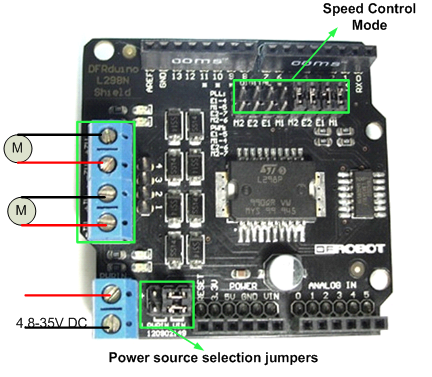
Control Mode Selection Jumpers: The shield supports PWM and PLL(Phased Locked Loop) control Modes. The PWM mode uses E1 and E2 to generate PWM signal. The PLL mode uses M1 and M2 to generate phase control signal.
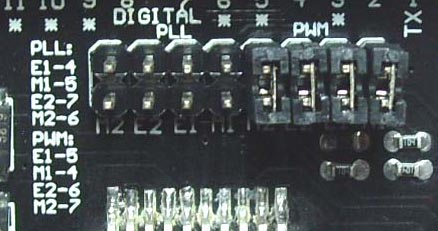
Motor Terminal: Two DC motors are connected to blue motor terminals. The male header behide the terminals are the same as the motor terminals.
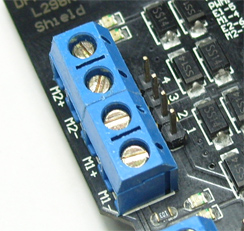
PWRIN: The motors can be powered by external power supply when the motor current exceeds the limits provided from the Arduino. The swith between external and Arduino power is implemented by two jumpers.
- PWRIN: External Power
- VIN: Arduino Power
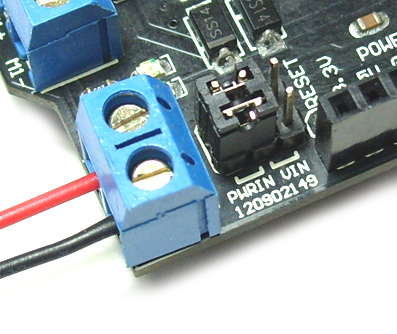
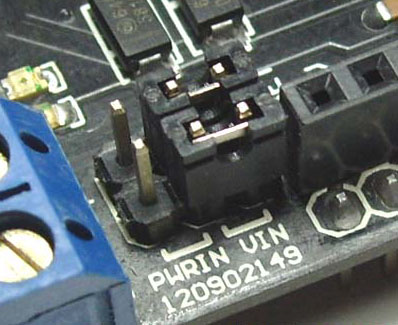
NOTE: When the motor shield is powered by external power source, make sure the external power source and Arduino have the same GND.
Control Signal Truth Table:
| E1 | M1 | E2 | M2 | ||
|---|---|---|---|---|---|
| L | X | Motor 1 Disabled | L | X | Motor 2 Disabled |
| H | H | Motor 1 Backward | H | H | Motor 2 Backward |
| PWM | X | PWM Speed control | PWM | X | PWM Speed control |
Note:H is High level ;L is Low level ;PWM is Pulse Width Modulation signal; X is any voltage level
Pin Allocation
| Pin | Function |
|---|---|
| Digital 4 | Motor 2 Direction control |
| Digital 5 | Motor 2 PWM control |
| Digital 6 | Motor 1 PWM control |
| Digital 7 | Motor 1 Direction control |
PWM Mode
| Pin | Function |
|---|---|
| Digital 4 | Motor 2 Enable control |
| Digital 5 | Motor 2 Direction control |
| Digital 6 | Motor 1 Direction control |
| Digital 7 | Motor 1 Enable control |
PLL Mode
Sample Code
//Arduino PWM Speed Control:
int E1 = 6;
int M1 = 7;
int E2 = 5;
int M2 = 4;
void setup()
{
pinMode(M1, OUTPUT);
pinMode(M2, OUTPUT);
}
void loop()
{
int value;
for(value = 0 ; value <= 255; value+=5)
{
digitalWrite(M1,HIGH);
digitalWrite(M2, HIGH);
analogWrite(E1, value); //PWM Speed Control
analogWrite(E2, value); //PWM Speed Control
delay(30);
}
}
Arduino PLL Speed Control:
int E1 = 7;
int M1 = 6;
int E2 = 4;
int M2 = 5;
void setup()
{
pinMode(M1, OUTPUT);
pinMode(M2, OUTPUT);
}
void loop()
{
int value;
for(value = 0 ; value <= 255; value+=5)
{
digitalWrite(M1,HIGH);
digitalWrite(M2, HIGH);
analogWrite(E1, value); //PLL Speed Control
analogWrite(E2, value); //PLL Speed Control
delay(30);
}
}
Arduino LCD&KeyPad Shield
Introduction
The LCD Keypad shield is developed for Arduino compatible boards, to provide a user-friendly interface that allows users to go through the menu, make selections etc. It consists of a 1602 white character blue backlight LCD. The keypad consists of 5 keys — select, up, right, down and left. To save the digital IO pins, the keypad interface uses only one ADC channel. The key value is read through a 5 stage voltage divider.
Diagram

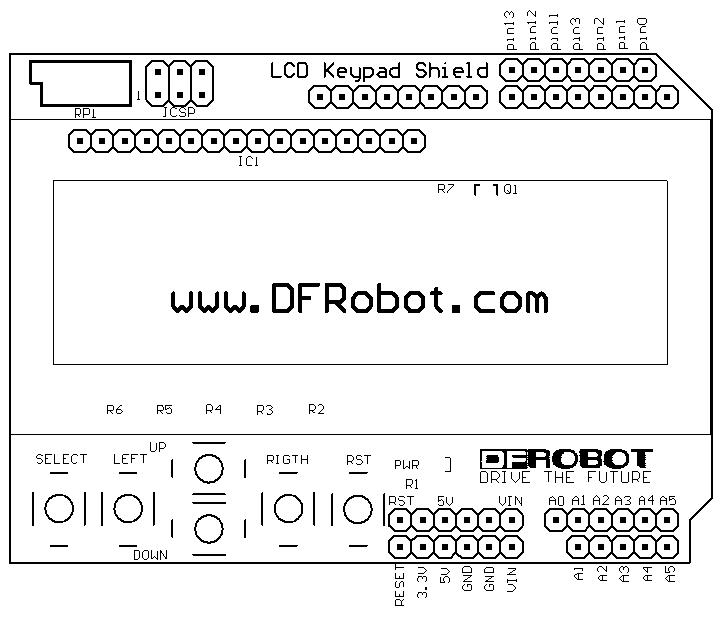
Pin Allocation
| Pin | Function |
|---|---|
| Analog 0 | Button (select, up, right, down and left) |
| Digital 4 | DB4 |
| Digital 5 | DB5 |
| Digital 6 | DB6 |
| Digital 7 | DB7 |
| Digital 8 | RS (Data or Signal Display Selection) |
| Digital 9 | Enable |
| Digital 10 | Backlit Control |
Sample Code
//example use of LCD4Bit_mod library
#include <LCD4Bit_mod.h>
//create object to control an LCD.
//number of lines in display=1
LCD4Bit_mod lcd = LCD4Bit_mod(2);
//Key message
char msgs[5][15] = {"Right Key OK ",
"Up Key OK ",
"Down Key OK ",
"Left Key OK ",
"Select Key OK" };
int adc_key_val[5] ={30, 150, 360, 535, 760 };
int NUM_KEYS = 5;
int adc_key_in;
int key=-1;
int oldkey=-1;
void setup() {
pinMode(13, OUTPUT); //we'll use the debug LED to output a heartbeat
lcd.init();
//optionally, now set up our application-specific display settings, overriding whatever the lcd did in lcd.init()
//lcd.commandWrite(0x0F);//cursor on, display on, blink on. (nasty!)
lcd.clear();
lcd.printIn("KEYPAD testing... pressing");
}
void loop()
{
adc_key_in = analogRead(0); // read the value from the sensor
digitalWrite(13, HIGH);
key = get_key(adc_key_in); // convert into key press
if (key != oldkey) // if keypress is detected
{
delay(50); // wait for debounce time
adc_key_in = analogRead(0); // read the value from the sensor
key = get_key(adc_key_in); // convert into key press
if (key != oldkey)
{
oldkey = key;
if (key >=0){
lcd.cursorTo(2, 0); //line=2, x=0
lcd.printIn(msgs[key]);
}
}
}
digitalWrite(13, LOW);
}
// Convert ADC value to key number
int get_key(unsigned int input)
{ int k;
for (k = 0; k < NUM_KEYS; k++)
{
if (input < adc_key_val[k])
{ return k; }
}
if (k >= NUM_KEYS)
k = -1; // No valid key pressed
return k;
}
Arduino Input Shield
Introduction
The Arduino Input Shield includes a two axis mini joystick (with moment switch) as well as two colored push buttons. The reserved APC220 module interface is to facilitate the realization of wireless rocker button controller. The shield can be easily stacked on top of your Arduino.
Diagram
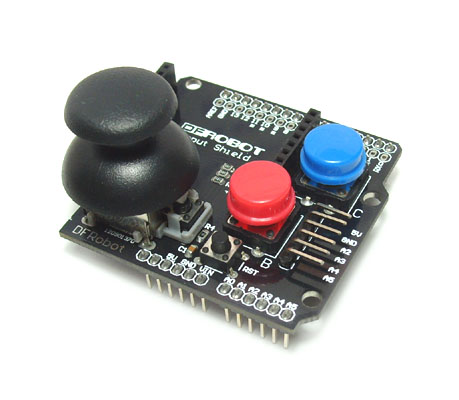
Pin Allocation
| Pin | Function |
|---|---|
| Digital 3 | Button B |
| Digital 4 | Button C |
| Digital 5 | Button A |
| Analog 0 | Y axis |
| Analog 1 | X axis |
PWM Mode
Sample Code
//This input shield use Digital Pin 3,4,5 (3 buttons) and Analog Pin 0,1 (JS)
// // Upload the code to Arduino
// www.dfrobot.com
// Last modified on 24/12/2009
int x=1;
int y=0;
int button_A= 5;
int button_B= 3;
int button_C= 4;
void setup()
{
int i;
for(i=3;i<=5;i++)
pinMode(i, INPUT);
pinMode(LED,OUTPUT);
}
void loop()
{
int val;
while(1)
{
val=analogRead(x); //Read Analog input
if(val>1000||val<20) digitalWrite(LED, HIGH);
else digitalWrite(LED,LOW);
val=analogRead(y);
if(val>1000||val<20) digitalWrite(LED, HIGH);
else digitalWrite(LED,LOW);
if(digitalRead(button_A)==0) //Check Button A
{
digitalWrite(LED, HIGH); // Set LED on
}
else digitalWrite(LED,LOW);
if(digitalRead(button_B)==0) //Check Button B
{
digitalWrite(LED, HIGH); // Set LED Off
}
else digitalWrite(LED,LOW);
if(digitalRead(button_C)==0) //Check Button C
{
digitalWrite(LED, HIGH); // Set LED off
}
else digitalWrite(LED,LOW);
}
}
Arduino Nano IO Shield
Introduction
The Nano IO Shield extends the Digital I/O with Power and GND Pins. A communication module socket provides an easy way to integrate APC220 RF module and DF-Bluetooth module which brings a wireless solution. A separate set of I2C pins make the I2C device connection.
Diagram
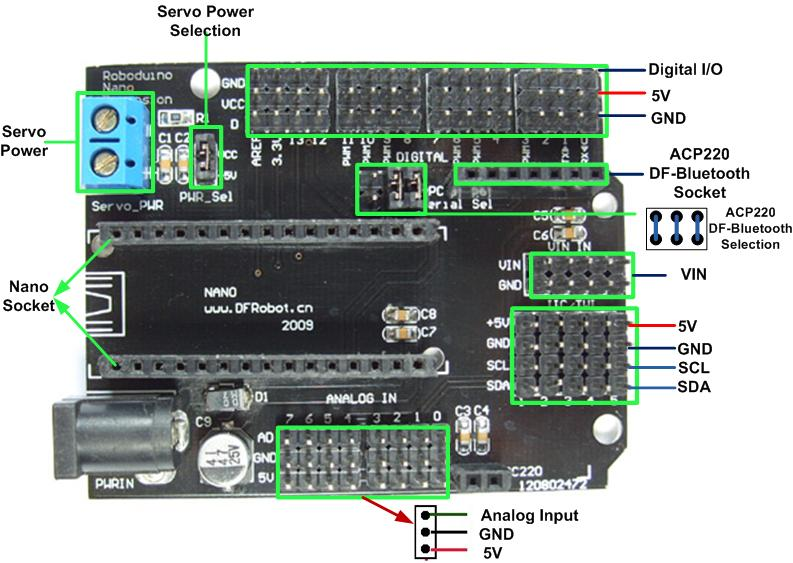
Sample Code
Not available
Compatible Table
| Diecimila | Duemilanove | Mega | Nano | Romeo | |
|---|---|---|---|---|---|
| IO Shield | Yes | Yes | Yes | No | No |
| Motor Shield | Yes | Yes | Yes | No | No |
| Ethernet Shield | No | Yes | No | No | Yes |
| LCD&Keypad Shield | Yes | Yes | Yes | No | No |
| Input Shield | Yes | Yes | Yes | No | Yes |
| XBee Shield | Yes | Yes | Yes | No | Yes |
| Nano IO Shield | No | No | No | Yes | No |
Stackable Table
| Shield Name | Stackable |
|---|---|
| IO Shield | Yes |
| Motor Shield | Yes |
| Ethernet Shield | Yes |
| LCD&Keypad Shield | No |
| Input Shield | No |
| XBee Shield | No |
| Nano IO Shield | No |
Control Pin Table
| Shield Name | Control Pin |
|---|---|
| IO Shield | None |
| Motor Shield | 6,7,8(5),9(4) |
| Ethernet Shield | 10,11,12,13 |
| LCD&Keypad Shield | Digital Pin: 4,5,6,7,8,9,10 Analog Pin: 0 |
| Input Shield | Digital Pin:3,4,5 Analog Pin: 0,1 |
| XBee Shield | 0,1 |
| Nano IO Shield | None |
Where to buy ?
| Region | Shop |
|---|---|
| USA/Canada | http://www.robotshop.ca |
| UK | http://www.yerobot.com |
| China | https://www.dfrobot.com |
| Taiwan | http://www.aroboto.com/ |
| Thailand | http://www.micro4you.com/ |
| Australia | http://www.littlebirdelectronics.com/ |
If you cannot find local shop? Please contact us at [email protected].
if you are interesting in to be one of our distributors, please contact us at [email protected].
| Revision | Date | Comments |
|---|---|---|
| 1.0 | 20 August 2009 | First Release |
| 1.1 | 2nd September 2009 | Add LCD pin out Diagram |
| 1.2 | 14th November 2009 | Modify Motor shield Pin allocation |
| 1.3 | 24th December 2009 | Modify Motor shield code |
| 1.4 | 28th December 2009 | Add Input Shield Code |
| 1.41 | 7th April 2010 | Add motor power supply information |
| 1.5 | 25th May 2010 | Add motor shield L298N |
category: Product_Manual category: DFR_Series category: Shields category: source category: Diagram